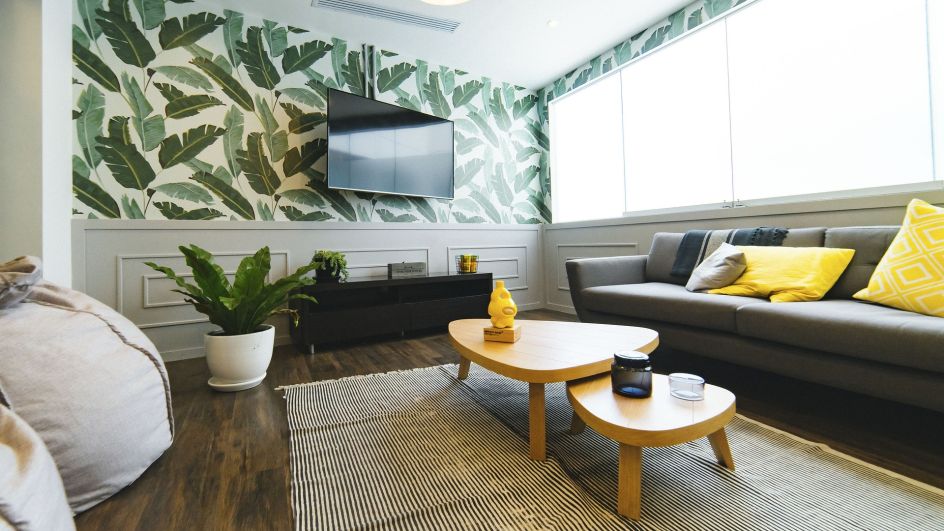Introduction
When it comes to home décor, wallpaper has made a remarkable comeback. Not only does it add texture and personality to your living room, but it also allows you to express your style in a unique way. As we step into 2024, new trends in wallpaper are emerging, offering fresh ideas to transform your living space. Whether you’re a DIY enthusiast or a first-timer, this guide will walk you through the entire process of selecting, preparing, and installing wallpaper in your living room.
Understanding Wallpaper Types
Vinyl Wallpaper
Vinyl wallpaper is one of the most popular choices due to its durability and versatility. It’s perfect for high-traffic areas and can withstand moisture, making it ideal for any room, including living rooms.
Benefits of Vinyl
Durability: Resistant to wear and tear.
Ease of Cleaning: Simple to wipe down with a damp cloth.
Variety: Available in numerous patterns and textures.
Non-Woven Wallpaper
Non-woven wallpaper is known for its ease of application and removal. It’s breathable, which helps prevent mold and mildew, making it a great choice for living rooms.
Why Choose Non-Woven?
Ease of Use: Simple to install and remove.
Breathability: Prevents mold and mildew.
Stability: Doesn’t expand or contract.
Fabric Wallpaper
Fabric wallpaper adds a luxurious touch to your living room. It’s available in various textures and patterns, offering a high-end look.
Pros and Cons
Pros: Elegant appearance, unique textures.
Cons: Can be difficult to clean, higher cost.
Peel and Stick Wallpaper
Peel and stick wallpaper is perfect for renters or those who like to change their décor frequently. It’s easy to apply and remove without damaging the walls.
Convenience and Style
Easy Application: No paste needed.
Removable: Perfect for temporary installations.
Variety: Wide range of styles and patterns.
Choosing the Right Wallpaper for Your Living Room
Considering Room Size and Lighting
When selecting wallpaper, consider the size of your room and the amount of natural light it receives. Light colors can make a small room appear larger, while dark colors can add coziness to a large space.
Matching with Furniture and Decor
Ensure your wallpaper complements your existing furniture and décor. Create a cohesive look by choosing patterns and colors that enhance the overall aesthetic of your living room.
Color Psychology in Wallpaper Selection
Colors can influence mood and atmosphere. Choose colors that create the desired ambiance in your living room. For example, blues and greens are calming, while reds and yellows are energizing.
Tools and Materials Needed
Essential Tools
Measuring tape
Level
Utility knife
Wallpaper smoother
Sponge
Additional Supplies for a Perfect Finish
Wallpaper paste (if not using peel and stick)
Drop cloth
Primer
Seam roller
Preparing Your Living Room Walls
Cleaning and Smoothing the Surface
Start by cleaning your walls thoroughly to remove dust and grease. A smooth surface is essential for the wallpaper to adhere properly.
Repairing Imperfections
Fill any holes or cracks with spackle and sand the surface smooth. This ensures a flawless finish.
Applying a Primer
Applying a primer helps the wallpaper adhere better and makes future removal easier. Use a primer suitable for your wall type.
Measuring and Cutting Wallpaper
Accurate Measurements
Measure the height and width of your walls to determine how much wallpaper you’ll need. Always buy extra to account for pattern matching and mistakes.
Cutting Techniques for Various Patterns
When cutting wallpaper, ensure you account for pattern repeats. Use a sharp utility knife and a straight edge for precise cuts.
Step-by-Step Installation Process
Applying Paste (for non-peel and stick wallpaper)
If using traditional wallpaper, apply an even layer of paste to the back of the wallpaper or the wall, depending on the type.
Aligning the First Strip
Start by aligning the first strip with a plumb line to ensure it’s straight. This is crucial for the overall appearance.
Smoothing and Trimming Excess
Use a wallpaper smoother to remove air bubbles and ensure the wallpaper adheres evenly. Trim any excess wallpaper at the top and bottom.
Matching Patterns and Seams
Carefully match patterns at the seams to create a seamless look. Use a seam roller to press the edges firmly together.
Finishing Touches
Removing Air Bubbles
Smooth out any remaining air bubbles with a sponge or wallpaper smoother. Work from the center outward to the edges.
Cleaning Up Edges and Corners
Ensure all edges and corners are neatly trimmed and adhered. Use a utility knife to carefully trim around outlets and switches.
Maintenance and Care Tips
Cleaning Different Types of Wallpaper
Different wallpapers require different cleaning methods. Vinyl and non-woven wallpapers can usually be wiped down with a damp cloth, while fabric wallpapers may need special care.
Handling Minor Repairs
For minor tears or loose seams, use a small amount of wallpaper paste to reattach. Press firmly with a seam roller.
2024 Wallpaper Trends
Bold Geometric Patterns
Geometric patterns are making a bold statement in 2024. These designs add a modern and dynamic feel to any living room.
Nature-Inspired Designs
Nature-inspired wallpapers bring the outdoors in, creating a tranquil and refreshing environment. Think florals, landscapes, and botanical prints.
Vintage Revival
Vintage wallpapers are back in style, offering a nostalgic charm with modern twists. These designs often feature intricate patterns and rich colors.
Minimalist Textures
Minimalist textures add subtle elegance to your living room. These wallpapers are perfect for creating a serene and sophisticated space.
Conclusion
Transforming your living room with wallpaper can be a rewarding project that adds character and style to your home. By following this step-by-step guide, you can confidently select, prepare, and install wallpaper that reflects your personal taste and the latest trends of 2024. Happy decorating!
FAQs
How Do I Choose the Right Wallpaper for My Living Room?
Consider factors like room size, lighting, existing décor, and the mood you want to create. Light colors can make a room feel larger, while darker shades add coziness.
Can I Install Wallpaper on My Own?
Yes, with the right tools and preparation, installing wallpaper can be a DIY project. Follow step-by-step guides and take your time to ensure a professional finish.
How Do I Remove Wallpaper?
To remove wallpaper, start by loosening a corner and peeling it back. Use a wallpaper steamer or solution to soften the adhesive if necessary.
What Are the Best Tools for Wallpaper Installation?
Essential tools include a measuring tape, level, utility knife, wallpaper smoother, and a sponge. Additional supplies like primer and seam roller can help achieve a perfect finish.
How Long Does Wallpaper Last?
With proper installation and care, wallpaper can last 10-15 years or longer. Maintenance and cleaning are key to preserving its appearance.

